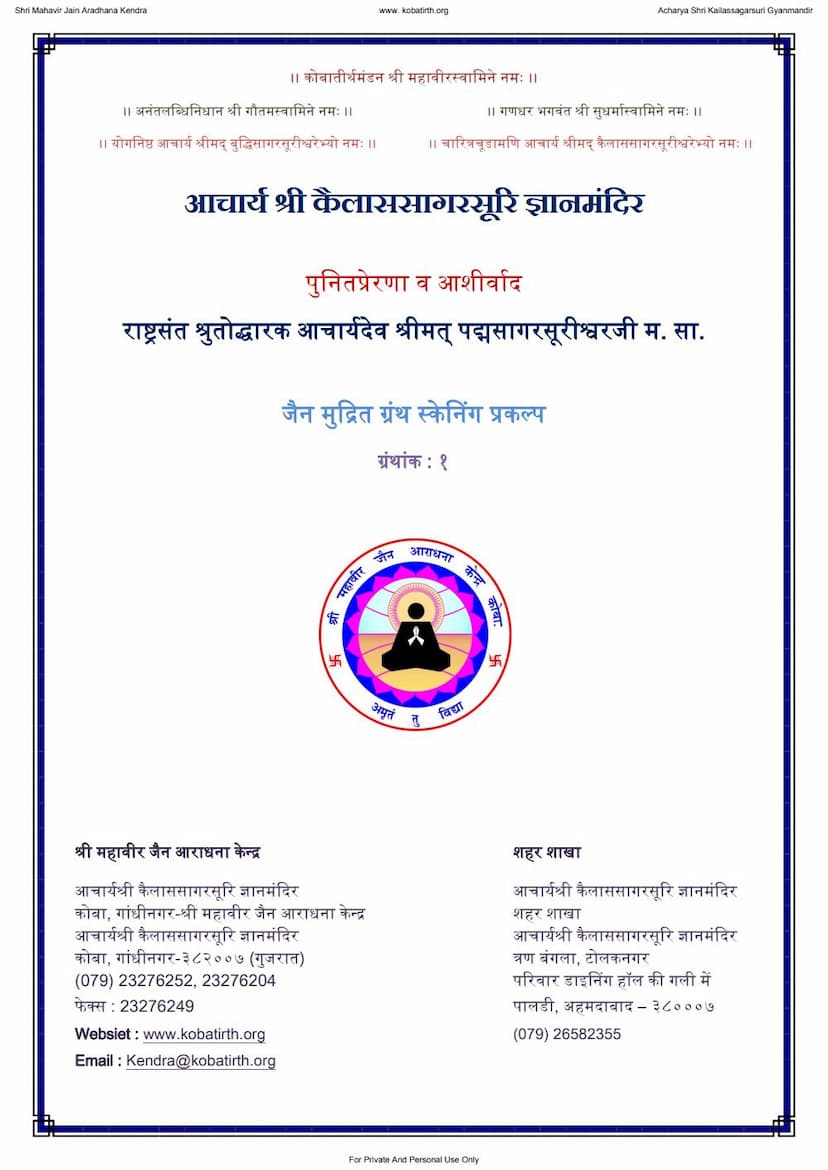Agam 17 Upang 06 Chandra Pragnapti Sutra Shwetambar
Added to library: September 1, 2025

Summary
This document is a digital copy of the Chandra Pragnapti Sutra (Chapter on the Moon), an Upanga (secondary scripture) within the Agamas of Shvetambara Jainism. The title identifies it as Agam 17 Upang 06. The specific edition is attributed to Purnachandrasagar and published by Jainanand Pustakalay.
The initial pages (1-11) are introductory and contain:
- Acknowledgments and Salutations: Expressing reverence to various Jain Acharyas (Gautamswami, Buddhisagarsuri, Mahavirswami, Sudharmaswami, Kailassagarsuri, Padmasagarsuri, and Anandsagarsuri). It also mentions the "Shri Mahavir Jain Aradhana Kendra" and "Acharya Shri Kailassagarsuri Gyanmandir" as the institutions involved in the scanning and publication project.
- Dedication: The work is dedicated to Acharya Shri Anandasagarsuri Maharaj, highlighting his role as an "Agamoddharak" (reviver of Agamas).
- Editors and Contributors: It lists the individuals and institutions involved in the editing, compilation, and publication, including Acharya Shri Purnachandrasagarji M.S. as the primary compiler, Acharya Shri Hemchandrasagar Suriji M.S. as the inspirational figure, and the Jainanand Pustakalay in Surat. Various other Acharyas and lay supporters are also acknowledged.
- Historical Context of Agam Recensions (Vachanas): A significant portion details the history of the Jain Agamas through six major recensions (Vachanas). This section explains the challenges faced in preserving the scriptural knowledge over time due to famines, political upheaval, and the decline of oral traditions.
- First Vachana: Held at Pataliputra under Sthulabhadra to compile the Dvadashangi after a severe famine.
- Second Vachana: Undertaken in Ujjain for the preservation of Agamas.
- Third Vachana: Conducted in Kalinga during a period of persecution, involving numerous monks and nuns.
- Fourth Vachana: In Dashpur (Malwa), where Aryarakshit Suri organized the four Anuyogas.
- Fifth Vachana: Carried out in Mathura and Valabhi due to disruptions caused by the era.
- Sixth Vachana: The most significant, held in Valabhi by Acharya Devardhigani Kshamashramana, where the 84 Agamas were systematically compiled and inscribed on palm leaves. This marked the culmination of efforts over 1000 years after Lord Mahavir's nirvana.
- Subsequent Efforts and Revival: The text laments the lack of further Agam recensions for 1500 years after the sixth Vachana and the subsequent decline in the transmission of Agamic knowledge. It then highlights the crucial role of Acharya Shri Anandasagar Surishwarji Maharaj in the 20th century for his dedicated efforts in researching, editing, and re-publishing the Agamas, which were previously scarce. The text emphasizes his monumental work in ensuring the survival and accessibility of these scriptures for future generations.
The core of the document, starting from Page #12, is the actual Chandra Pragnapti Sutra itself, written in Prakrit with Sanskrit glosses and explanations. This section meticulously details:
- The Movement and Characteristics of Celestial Bodies: The Sutra delves into astronomical calculations and descriptions, primarily focusing on the Sun and Moon.
- Sun's Movement: It describes the Sun's journey through various celestial circles (mandals) and its changing duration of daylight and nighttime throughout the year. It meticulously details the transitions between these circles, the addition and subtraction of time segments, and the resulting variations in day and night length. The concept of "addhamandala" (half-circles) and their north-south and east-west movements is explained.
- Sun's Path and Equivalence: It discusses how the Sun's position and the celestial circles it traverses affect its perceived speed and the length of its path. It also introduces the idea of two suns (Bharata and Airavata) and their independent movements and interactions.
- Celestial Bodies and Their Paths: The text describes how the Sun, Moon, and stars move through different circles and their relative distances.
- Shapes and Dimensions: The dimensions and shapes of various celestial circles ("mandala") are described, including their width, length, and circumference, with detailed measurements in yojanas.
- Orbital Paths and Transitions: It explains how the celestial bodies transition from one circle to another and the calculations involved in these movements.
- Luminous Bodies and Their Influence: The text describes how the Sun and Moon illuminate and affect different regions of the cosmos.
- Lunar and Solar Phases: It discusses the waxing and waning of the Moon and the phases of the Sun, including their relative speeds and cycles.
- Nakshatras (Lunar Mansions): A significant portion is dedicated to the 27 Nakshatras, their positions, durations, their association with the Moon and Sun, their respective gods, and their configurations.
- Calendar Systems: The Sutra outlines different calendar systems, including the Nakshatra-based year, lunar cycles, solar cycles, and their interrelationships.
- Cosmic Geography: It refers to the structure of the universe, including continents (like Jambudvipa), oceans, mountains (like Meru and Mandara), and the cosmic egg.
- Rahu's Role: The text addresses the concept of Rahu, describing it as a celestial entity that influences the eclipses of the Sun and Moon, though it also clarifies that it's not a physical entity that "eats" them. It provides detailed descriptions of Rahu's forms, colors, and movements.
- Celestial Beings and Their Enjoyments: It touches upon the celestial beings residing in the various luminaries and their levels of sensory enjoyments, comparing them to human experiences but highlighting the vastly superior nature of celestial pleasures.
- The "Acharya Shri Kailassagarsuri Gyanmandir" and "Jainanand Pustakalay" are central to the presentation, with the Sutra presented in a script derived from their efforts.
In essence, the Chandra Pragnapti Sutra is a highly detailed Jain astronomical text that explains the mechanics of the solar and lunar systems, the calendar, and related cosmic phenomena, all within the framework of Jain cosmology and philosophy. It showcases the advanced scientific knowledge possessed by ancient Jain scholars.